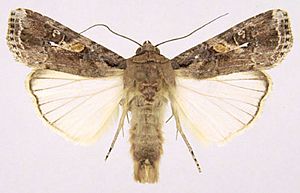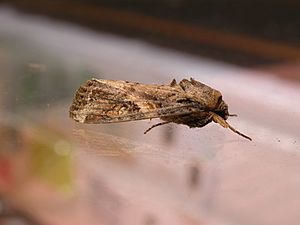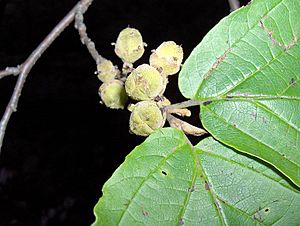Fall armyworm facts for kids
Quick facts for kids Fall armyworm |
|
|---|---|
 |
|
 |
|
| Scientific classification |
The fall armyworm (Spodoptera frugiperda) is a type of moth larva. It's called an "armyworm" because these larvae often move in large groups, like an army, and can invade and destroy many plants. This insect is known as a pest because it can damage and destroy a wide variety of crops. This causes big problems for farmers and the economy.
The scientific name frugiperda comes from Latin words meaning "lost fruit." This name was given because of how much damage these worms can do to crops. Because they are so destructive, scientists have studied the fall armyworm a lot. They want to find ways to protect crops from them. These worms are also interesting because they seem to be slowly splitting into two different types of species. Another cool fact is that the larvae sometimes eat each other. This helps them control diseases among themselves.
The fall armyworm is active at a different time of year than the "true armyworm." True armyworms usually appear in early summer. Fall armyworms cause most of their damage in late summer in the southern United States. In northern areas, they are most active in early fall.
Contents
- What Does the Fall Armyworm Look Like?
- Where Do Fall Armyworms Live?
- What Do Fall Armyworms Eat?
- Fall Armyworm Life Cycle
- How Fall Armyworms Travel
- Who Are the Fall Armyworm's Enemies?
- Different Types of Fall Armyworms
- How Fall Armyworms Mate
- How Fall Armyworms Affect Humans
- Images for kids
- See also
What Does the Fall Armyworm Look Like?
Adult fall armyworm moths are about 32 to 40 millimeters (1.25 to 1.5 inches) wide from wing tip to wing tip. They have brown or gray front wings and white back wings. Male moths have more patterns on their wings and a clear white spot on each front wing.
When they are very young larvae (caterpillars), they are light-colored with a larger dark head. As they grow, they become browner and get white lines along their bodies. They also develop dark spots with small spines. A key feature of the caterpillar is an upside-down "Y" shape on its head.
Where Do Fall Armyworms Live?
Native Homes
The fall armyworm naturally lives across eastern and central North America and in South America. They cannot survive freezing temperatures. This means they only live through the winter in the warmest parts of the United States, like Texas and Florida. Because of this, they are a bigger problem in the southeastern states. However, as the weather gets warmer, they spread across the eastern United States. They can even reach southern Canada during the warmer months, finding places with enough food.
New Places They Have Spread To
Scientists have used computer models to guess where fall armyworms could spread around the world. These models show that many places in Europe, South Africa, China, and Australia are only suitable for them during warmer months.
The fall armyworm was first found in Africa in 2013 in Sao Tome. From there, it spread to countries like Nigeria, Benin, Togo, and Ghana by 2017. In December 2020, it was found in Syria. It is believed to have arrived there from Jordan.
It was widely reported in Africa in 2016. It caused a lot of damage to corn crops. It has since spread to 28 countries in Africa. In December 2018, it started spreading quickly in India. In January 2019, many corn farms in Sri Lanka were heavily infested.
The pest was first found in China in January 2019. By the end of 2019, it had infested 26 provinces. It was expected to reach China's wheat belt in 2020. The situation was called "very grave" by the government. In June 2019, it was also found in Southeast Asia.
In January 2020, fall armyworms were found on the Torres Strait Islands in Australia. By February, they were in North Queensland. They continued to spread across Queensland, the Northern Territory, and Western Australia. In September, they were found in New South Wales. Within a week, it was officially declared that they could not be completely removed from Australia. In April 2020, they were detected in Papua New Guinea, spreading across the Torres Strait.
Bangladesh
Fall armyworms were first found in Bangladesh in late 2018. By January 2020, they had reached 37 districts. To help fight this pest, experts suggest using two types of natural pesticides. These include a specific virus that attacks the armyworm and a type of wasp.
What Do Fall Armyworms Eat?
Caterpillars
The fall armyworm caterpillars mainly eat grasses and grain crops like corn. However, they have been seen eating over 80 different kinds of plants. They got their name "armyworm" because they eat almost all the plants they find as they spread out, just like a large army.
Some types of sweet corn have a partial ability to fight off armyworms. This is because the corn produces a special protein when armyworms or other larvae feed on it. This protein has been shown to slow down the growth of fall armyworm larvae.
Adults
Adult moths drink nectar from flowers. One example is the flower of the witch hazel plant.
Fall Armyworm Life Cycle
The fall armyworm's life cycle takes about 30 days in summer. It takes 60 days in spring and autumn. In winter, it can take 80 to 90 days. A female moth usually lays about 1,500 eggs in her lifetime. The larvae cannot survive very cold temperatures.
Egg Stage
The armyworm egg is shaped like a dome. It is about 0.4 millimeters (1/64 inch) wide and 0.3 millimeters (1/96 inch) tall. Females prefer to lay eggs on the underside of leaves. But if there are many moths, they will lay eggs almost anywhere. In warm weather, the eggs hatch into larvae in just a few days.
Larva Stage
The larvae go through six different growth stages, called instars. Each stage looks a little different. The larva stage lasts from 14 to 30 days, depending on the temperature. A fully grown caterpillar is about 3.8 to 5 centimeters (1.5 to 2 inches) long. This is the most damaging stage because the larvae have strong biting mouth parts. They eat a lot of plants during this time.
Pupa Stage
After the larva stage, the caterpillars turn into pupae. They do this underground inside a cocoon made of soil and silk. This pupa stage lasts from 7 to 37 days. How long they stay in this stage and how well they survive depends on the temperature.
Adult Stage
Once they become adults, the moths live for about 10 days, sometimes up to 21 days. Females lay most of their eggs early in their adult life. Adult moths are active at night. They do best on warm and humid nights.
How Fall Armyworms Travel
Adult moths can fly very long distances. Even though they cannot survive winter north of the southern United States, they can fly as far north as southern Canada in warm months. They migrate very fast, traveling about 300 miles for each generation. Some scientists think that strong winds from weather fronts help them travel so quickly.
Who Are the Fall Armyworm's Enemies?
Predators
Many animals eat fall armyworm caterpillars. These include birds, rodents, beetles, earwigs, and other insects. These predators can greatly reduce the number of caterpillars. The main way larvae protect themselves is by growing in huge numbers and moving to new places before predators can find them all.
Parasitoids
Certain flies and wasps are parasitoids of the fall armyworm. This means they lay their eggs on or inside the armyworm, and their young then feed on the armyworm, eventually killing it. Common parasitoids include Archytas marmoratus, Cotesia marginiventris, and Chelonus texanus. In 2018, tiny wasps were found attacking armyworm eggs in East Africa.
Parasites and Diseases
Scientists have found 53 different types of parasites in fall armyworm larvae. Even with diseases, larvae can often survive because their life cycle is so fast. However, scientists are studying these parasites to find new ways to fight armyworm attacks on crops. One idea is to move parasites from South America to North America, and vice versa.
Different Types of Fall Armyworms
The fall armyworm might be slowly splitting into two different species. These two types have important genetic differences. These differences are linked to the plants they prefer to eat, even though both types live in the same areas. These two types are generally called a "rice strain" and a "corn strain." This separation is happening because they prefer different host plants and have different mating behaviors. For example, they might mate at different times of night or use different scents to attract mates.
How Fall Armyworms Mate
Female moths attract males by sitting on a plant where they feed and releasing a special scent called a pheromone. This scent tells males she is ready to mate. A female only mates once per night. This can lead to conflicts between males who fly to a female. Virgin females (those who haven't mated yet) call and mate first during the night. Females who have mated once go next, and those who have mated multiple times call and mate last.
How Fall Armyworms Affect Humans
Pests of Crop Plants
Because of what they like to eat, fall armyworm larvae can cause huge damage to many crops. The first time their destruction was recorded was in 1797 in Georgia, USA. Damage can happen almost overnight. This is because young caterpillars eat very little, but older ones eat about 50 times more! Because of this sudden increase in eating, farmers might not notice the larvae until they have destroyed almost everything in just one night.
Some crops they target include cotton, tobacco, sweet corn, rice, peanuts, and even fruits like apples and oranges. The list of plants they can eat is very long. It's estimated that almost 40% of the plants armyworms target are important for the economy. Since the larvae eat so much of the plant, they are very harmful to crop survival and how much food a farm can produce. In corn, larvae will even burrow into the corn ear to eat the kernels.
Fall Armyworm in Africa
The fall armyworm was found in Africa in 2016. In early 2017, armyworms infested large areas of corn crops across southern Africa. This greatly harmed many farmers' ability to make a living. It is thought they arrived as an invasive species from the Americas, possibly as eggs in imported food. This is a big worry for farming experts. They are concerned about the huge damage this invasive species could do to African food crops if it spreads further. Many African countries have agreed to take urgent action against armyworms.
Managing the Pest
Experts have several ideas for managing fall armyworms. These include planting crops early and avoiding planting crops at different times. They also suggest planting other crops like cassava or yam alongside corn, as these are not affected by armyworms. Another tip is to keep shelters and flowering plants around fields for helpful insects like ground beetles and parasitoids.
A technique called 'push-pull' can also be used. This involves planting certain crops like Desmodium and Napier grass to either push the armyworms away or pull them towards a trap crop. For crops like wheat, sorghum, millet, and rice, it's recommended to plant varieties that grow quickly and are less preferred by the armyworm.
Because fall armyworms are so destructive, farmers must work hard to stop them. Insecticides are often used. In southern regions, farmers might need to spray corn with insecticide every day. Another plan is to plant crops earlier in the season. This helps avoid the time when armyworm numbers increase as summer goes on. In South Africa, farmers are using special traps with scents to catch and remove male armyworms. This helps stop them from mating. Scientists are also working to create new types of corn that can naturally fight off the fall armyworm.
Research Use
Special cells from S. frugiperda (called Sf9 and Sf21 cells) are often used in science research. They help scientists make special proteins using insect viruses.
Invasion of Sri Lanka
After being reported in India in May 2018, the Sri Lankan Ministry of Agriculture warned farmers about a possible fall armyworm invasion. At the time of the warning, crop damage was already reported in some areas. The larvae are known locally as Sena dalambuwa (armyworm caterpillar). Not only corn, but also sugarcane farms were attacked.
In December 2018, many corn farms were heavily infested. The moth quickly spread across the country within weeks. By the end of January 2019, the armyworm was present in almost all districts of Sri Lanka.
The Sri Lankan Department of Agriculture suggested using 12 different pesticides. An organic farming expert suggested sprinkling rice husk ashes to keep the worms away. The Ministry of Agriculture also decided to use agricultural drones to spray insecticides. This helps control the caterpillars over large areas. In January 2019, caterpillars were also found in rice fields in some areas.
Images for kids
See also
 In Spanish: Cogollero del maíz para niños
In Spanish: Cogollero del maíz para niños






